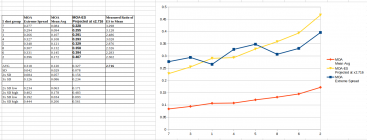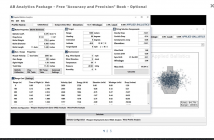Since I've started doing my own barrels (large thanks to everyone on this site) I've been nerding out a lot more on group sizes since I want to now test both my shooting capability as well as my skills on the the lathe and workbench. Here is some food for thought on a practical experiment I did in July.
The setup is that I wanted to really test how much my group sizes and zero "shift" in a rigerous manner - so I took what is my PRS match load (6 BRA, 109 hybrids) and shot two 5 shot groups at 100 yards, every week for -4 weeks- over the course of July (usually about 9:30 am morning, chosen on the better weather of wed/thurs). Gunsmithing is by me and shot off a harris front bipod and fancy rear sandbag (gamechanger) that I recently moved to using with a different hold technique.
I'm a statistical guy so I looked at both the ES and the Mean avg in group sizes to see how it changed versus what mean to ES would be projected by the literature. Groups ranged from .277-.396 with a mean ov .318 moa and a SD of .042.
At first glance I was surprised at both how consistent they were and how little the zero appeared to shift, no group was centered outside of a .1mil scope click adjustment. But when you put it into excel you realize that the largest group .396 is almost 40% bigger than the smallest group, thats a lot.
If you look at the low and high group sizes at 2 or 3 SD out, for me to have confidence that a new load, or barrel is shooting better than this (since clearly I as the shooter can say I'm capable of shooting low .3's now) I would have to shoot groups that are in the low .2's or high .1's.
I could chase a load a long time in the .2's and it might not really be meaningfully different than my current load. Plus, without moving to flat back bullets, a f-class front rest, benchrest style rear bag - how do i know its not me that is not limiting the varience. After all, its a harris biopod and a rear squeeze bag!
Here is the raw data that might be of interest to someone one day.













